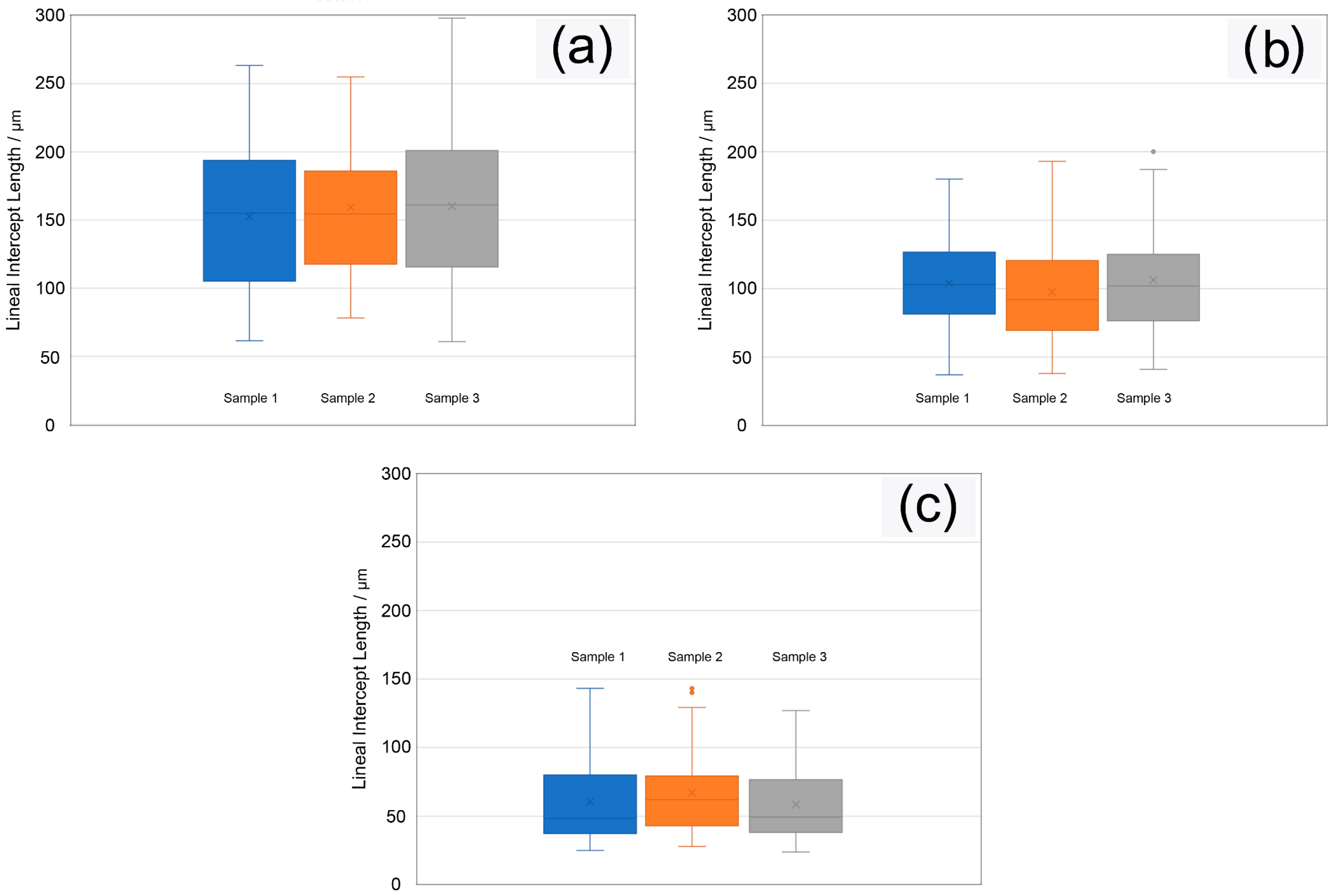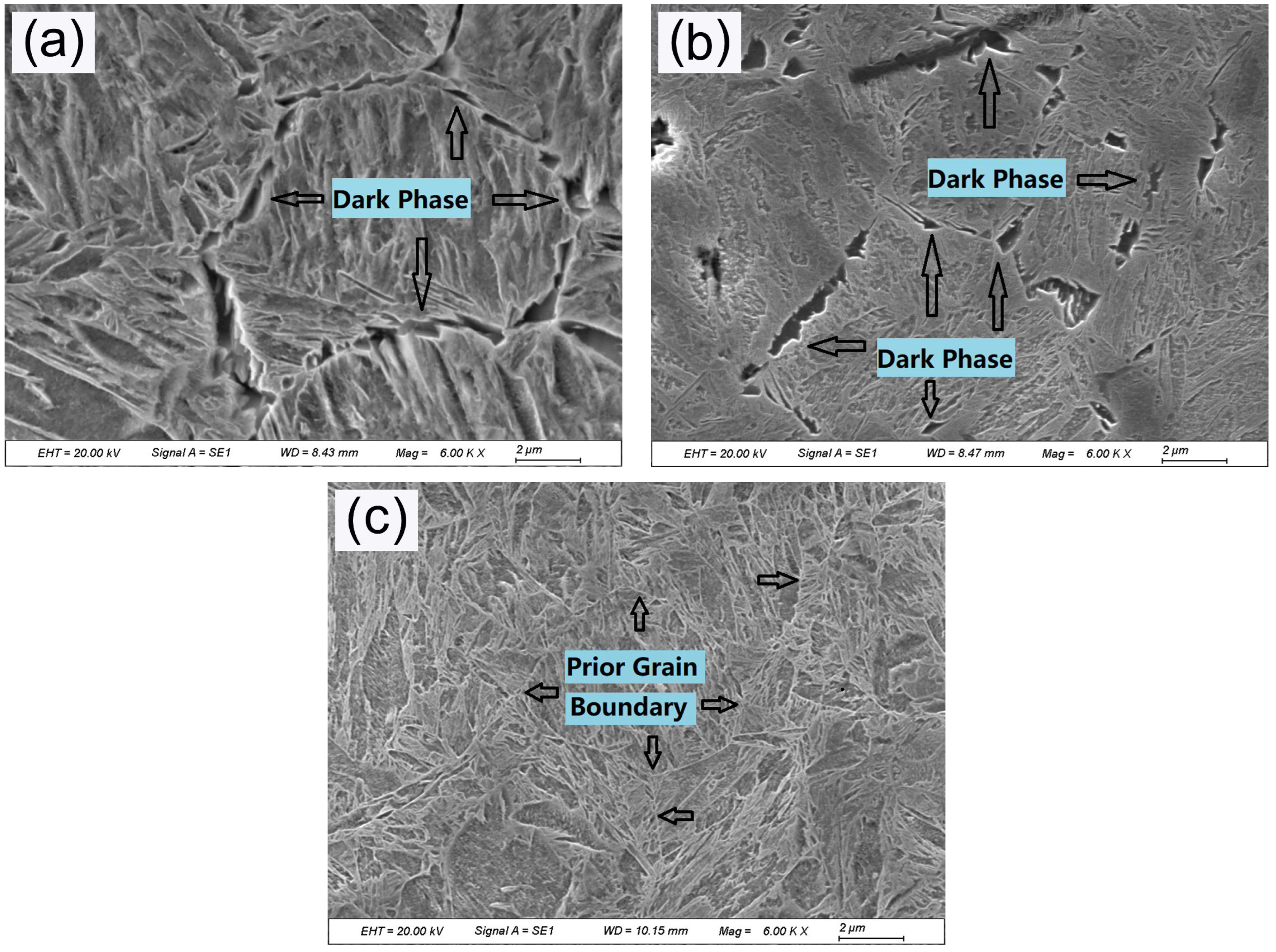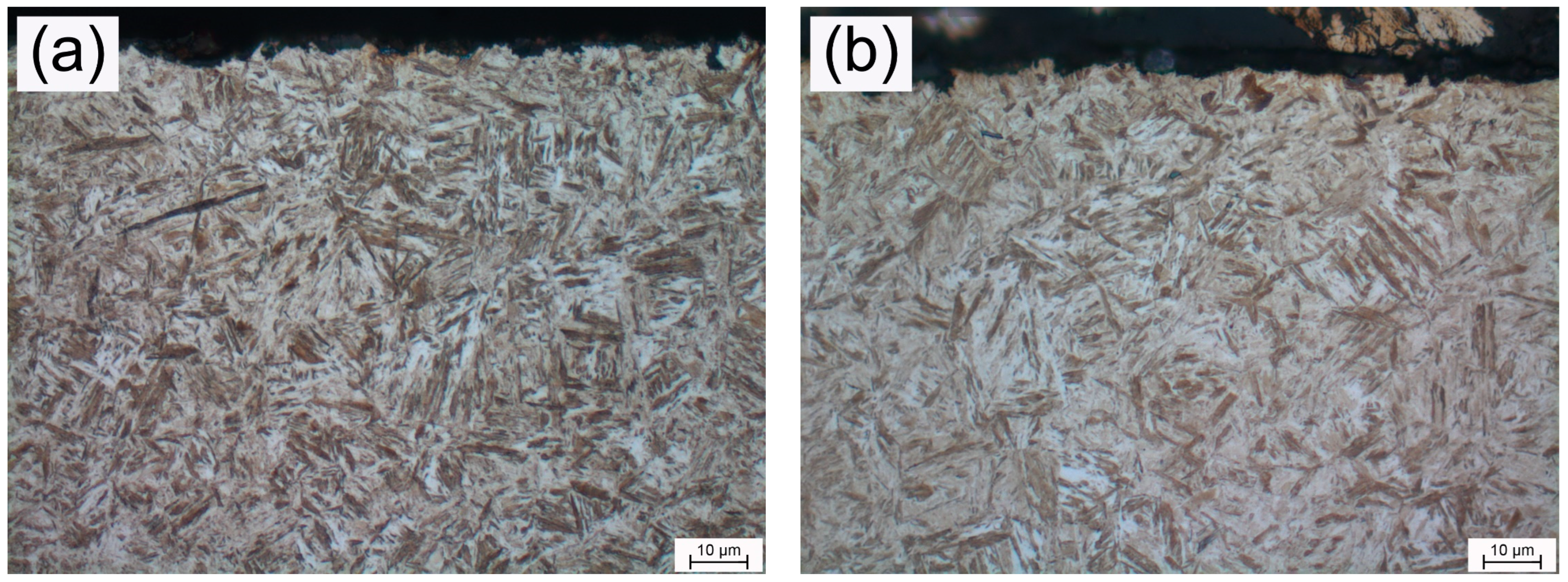Effect of Initial Intergranular Ferrite Size on Induction Hardening Microstructure of Microalloyed Steel 38MnVS6
Abstract
1. Introduction
2. Materials and Methods
2.1. Raw Material
2.2. Induction Hardening
2.3. Microstructural Characterization
3. Results
3.1. Initial Microstructure
3.2. Induction Hardened Microstructure
3.3. Identification of Dark Phase
4. Discussion
4.1. Effect of Initial Intergranular Ferrite Size
4.2. Actions Preventing Dark Ferrite
5. Conclusions
Author Contributions
Funding
Data Availability Statement
Acknowledgments
Conflicts of Interest
References
- Thewillis, G.; Naylor, D.J. New alloys help cut the cost of forged steel components. Met. Mater. 1981, 12, 21–28. [Google Scholar]
- Ko, Y.S.; Kim, S.H.; Park, H.; Lim, J.D. Assessment of microalloying effect to the new automotive forged steel parts. In Proceedings of the 2006 International Forum on Strategic Technology, Ulsan, Republic of Korea, 18–20 October 2006; pp. 170–173. [Google Scholar] [CrossRef]
- Baker, T.N. Microalloyed steels. Ironmak. Steelmak. 2016, 43, 264–307. [Google Scholar] [CrossRef]
- Zhao, M.; Hanamura, T.; Qiu, H.; Yang, K. Precipitation of carbonitrides and their strengthening upon non-quench aging for micro-alloyed acicular ferrite pipeline steels. Mater. Trans. 2005, 46, 784–789. [Google Scholar] [CrossRef]
- Baker, T.N. Processes, microstructure and properties of vanadium microalloyed steels. Mater. Sci. Technol. 2019, 25, 1083–1107. [Google Scholar] [CrossRef]
- Medina, S.F.; Gómez, M.; Rancel, L. Grain refinement by intragranular nucleation of ferrite in a high nitrogen content vanadium microalloyed steel. Scr. Mater. 2008, 58, 1110–1113. [Google Scholar] [CrossRef]
- Fang, W.; Zhang, C.; Gou, F.; Jiang, B.; Zhang, C.; Liu, Y. The effect of micro alloying elements (vanadium, titanium) additions on the austenite grain growth behavior in medium carbon steel containing nitrogen. Mater. Werkst. 2020, 51, 230–237. [Google Scholar] [CrossRef]
- Zajac, S.; Siwecki, T.; Hutchinson, W.B.; Lagneborg, R. Strengthening mechanisms in vanadium microalloyed steels intended for long products. ISIJ Int. 1998, 38, 1130–1139. [Google Scholar] [CrossRef]
- Dini, G.; Vaghefi, M.M.; Shafyei, A. The influence of reheating temperature and direct-cooling rate after forging on microstructure and mechanical properties of V-microalloyed steel 38MnSiVS5. ISIJ Int. 2006, 46, 89–92. [Google Scholar] [CrossRef]
- Gu, S.; Zhang, L.; Ruan, J.; Zhou, P.; Zhen, Y. Constitutive modeling of dynamic recrystallization behavior and processing map of 38MnVS6 non-quenched steel. J. Mater. Eng. Perform. 2014, 23, 1062–1068. [Google Scholar] [CrossRef]
- Gu, S.; Zhang, L.; Zhang, C.; Ruan, J.; Zhen, Y. Modeling the effects of processing parameters on dynamic recrystallization behavior of deformed 38MnVS6 steel. J. Mater. Eng. Perform. 2015, 24, 1790–1798. [Google Scholar] [CrossRef]
- Scurria, M.; Emre, S.; Möller, B.; Wagener, R.; Melz, T. Evaluation of the influence of MnS in forged steel 38MnVS6 on fatigue life. SAE Int. J. Engines 2017, 10, 366–372. [Google Scholar] [CrossRef]
- Lomate, D.; Tewari, A.; Date, P.; Ukhande, M.R.; Shegavi, G.M.; Singh, R.K.P. Fatigue life prediction of induction hardened case depth specimens made from 38MnVS6 micro alloyed steel. In SAE Technical Paper; SAE International: Detroit, MI, USA, 2017. [Google Scholar] [CrossRef]
- Vidhyasagar, M.; Balachandran, G. An assessment of ladle furnace steel-making reactions in an aluminium-killed 38MnS6 Steel. Trans. Indian Inst. Met. 2020, 73, 479–495. [Google Scholar] [CrossRef]
- Erçayhan, Y.; Saklakoğlu, N. The effect of thermomechanical process on metallurgical and mechanical properties of 38MnVS6 micro alloyed steel. Mater. Werkst. 2021, 52, 644–654. [Google Scholar] [CrossRef]
- Xie, Y.; Meng, X.; Deng, X.; Li, S. Large (Ti, V) carbonitride in nonquenched and tempered steel 38MnVS6. Adv. Mater. Sci. Eng. 2022, 2022, 7281399. [Google Scholar] [CrossRef]
- Sun, Y.; Li, Y.; Wu, W.; Jiang, Y.; Li, J. Effect of inclusions on pitting corrosion of C70S6 non-quenched and tempered steel doped with Ca and Mg. Acta Metall. Sin. 2022, 58, 895–904. (In Chinese) [Google Scholar]
- Dong, X.; Kong, D. Sulfide inclusion-induced micro-scaled pitting corrosion on crankshaft surface in indoor atmospheric environment. J. Fail. Anal. Prev. 2024, 24, 700–707. [Google Scholar] [CrossRef]
- Wu, W.; Yang, S.; Suo, D.; Tan, X.; Jiang, Y.; Li, J.; Sun, Y. Effect of tellurium treatment on the pitting behavior of 38MnVS6 non-quenched and tempered steel in alkaline environment. Corros. Sci. 2024, 226, 111629. [Google Scholar] [CrossRef]
- Prisco, U. Case microstructure in induction surface hardening of steels: An overview. Int. J. Adv. Manuf. Technol. 2018, 98, 2619–2637. [Google Scholar] [CrossRef]
- López-Martínez, E.; Vázquez-Gómez, O.; Vergara-Hernández, H.J.; Campillo, B. Effect of initial microstructure on austenite formation kinetics in high-strength experimental microalloyed steels. Int. J. Miner. Met. Mater. 2015, 22, 1304–1312. [Google Scholar] [CrossRef]
- Javaheri, V.; Kolli, S.; Grande, B.; Porter, D. Insight into the induction hardening behavior of a new 0.40% C microalloyed steel: Effects of initial microstructure and thermal cycles. Mater. Charact. 2019, 149, 165–183. [Google Scholar] [CrossRef]
- DIN EN 10267: 1998; Ferritic-Pearlitic Steels for Precipitation Hardening from Hot-Working Temperatures. German Institute for Standardisation: Berlin, Germany, 1998.
- ISO 643:2024; Steels—Micrographic Determination of the Apparent GRAIN Size. ISO: Geneva, Switzerland, 2019.
- Zuo, X.; Chen, Y.; Wang, M. Study on microstructures and work hardening behavior of ferrite-martensite dual-phase steels with high-content martensite. Mater. Res. 2012, 15, 915–921. [Google Scholar] [CrossRef][Green Version]
- Fereiduni, E.; Ghasemi Banadkouki, S.S. Improvement of mechanical properties in a dual-phase ferrite–martensite AISI4140 steel under tough-strong ferrite formation. Mater. Des. 2014, 56, 232–240. [Google Scholar] [CrossRef]
- Ghasemi Banadkouki, S.S.; Fereiduni, E. Effect of prior austenite carbon partitioning on martensite hardening variation in a low alloy ferrite–martensite dual phase steel. Mater. Sci. Eng. A 2014, 619, 129–136. [Google Scholar] [CrossRef]
- Wang, S.; Yu, H.; Zhou, T.; Wang, L. Synergetic effects of ferrite content and tempering temperature on mechanical properties of a 960 MPa grade HSLA steel. Materials 2018, 11, 2049. [Google Scholar] [CrossRef] [PubMed]
- Gao, B.; Liu, Y.; Chen, X.; Sui, Y.; Sun, W.; Xiao, L.; Zhou, H. Heterogeneous plastic deformation and HDI strengthening of the heterostructured dual-phase steels investigated by in-situ SEM-DIC. Mater. Sci. Eng. A 2024, 893, 146149. [Google Scholar] [CrossRef]
- García de Andrés, C.; Caballero, F.G.; Capdevila, C. Dilatometric characterization of pearlite dissolution in 0.1C-0.5Mn low carbon low manganese steel. Scr. Mater. 1998, 38, 1835–1842. [Google Scholar] [CrossRef][Green Version]
- Caballero, F.G.; Capdevila, C.; García de Andrés, C. Modelling of kinetics and dilatometric behaviour of austenite formation in a low-carbon steel with a ferrite plus pearlite initial microstructure. J. Mater. Sci. 2002, 37, 3533–3540. [Google Scholar] [CrossRef]
- Andrews, K.W. Empirical formulae for the calculation of some transformation temperatures. J. Iron Steel Inst. 1965, 203, 721–727. [Google Scholar]
- Chang, L.C.; Bhadeshia, H.K.D.H. Austenite films in bainitic microstructures. J. Mater. Sci. Technol. 1995, 11, 874–882. [Google Scholar] [CrossRef]
- Gaude-Fugarolas, D.; Bhadeshia, H.K.D.H. A model for austenitisation of hypoeutectoid steels. J. Mater. Sci. 2003, 38, 1195–1201. [Google Scholar] [CrossRef]
- Guzman-Garfias, R.; Vázquez-Gómez, O.; Garnica-González, P.; Vergara-Hernández, H.J.; Barrera-Godínez, J.A. Effect of the heating rate on the austenite formation kinetics by isoconversion method in Cr–Mo–V steel. In TMS 2024 153rd Annual Meeting & Exhibition Supplemental Proceedings; The Minerals, Metals & Materials Series; Springer: Cham, Switzerland, 2024. [Google Scholar] [CrossRef]
- Macedo, M.Q.; Cota, A.; Gabriel da Silva Araujo, F. The kinetics of austenite formation at high heating rates. Rem Rev. Esc. De Minas 2011, 64, 163–167. [Google Scholar] [CrossRef]
- Lagneborg, R.; Siwecki, T.; Zajac, S.; Hutchinson, B. The role of vanadium in microalloyed steels. Scand. J. Metall. 1999, 28, 186–241. [Google Scholar]
- Gu, C.; Scott, C.; Fazeli, F.; Gaudet, M.J.; Su, J.; Wang, X.; Bassim, N.; Zurob, H. Evolution of the microstructure and mechanical properties of a V-containing microalloyed steel during coiling. Mater. Sci. Eng. A 2023, 880, 145332. [Google Scholar] [CrossRef]
- Zhou, Q.; Li, Z.; Wei, Z.S.; Wu, D.; Li, J.Y.; Shao, Z.Y. Microstructural features and precipitation behavior of Ti, Nb and V microalloyed steel during isothermal processing. J. Iron Steel Res. Int. 2019, 26, 102–111. [Google Scholar] [CrossRef]
- Sun, L.; Zhang, S.; Song, R.; Ren, S.; Zhang, Y.; Sun, X.; Dai, G.; Hao, Y.; Huo, W.; Zhao, S.; et al. Effect of V, Nb, and Ti microalloying on low–temperature impact fracture behavior of non–quenched and tempered forged steel. Mater. Sci. Eng. A 2023, 879, 145299. [Google Scholar] [CrossRef]
- Wang, L.; Wang, S. Study on Austenite Transformation and Growth Evolution of HSLA Steel. Materials 2023, 16, 3578. [Google Scholar] [CrossRef]
- Zhao, F.; He, G.-N.; Liu, Y.-Z.; Zhang, Z.-H.; Xie, J.-X. Effect of titanium microalloying on microstructure and mechanical properties of vanadium microalloyed steels for hot forging. J. Iron Steel Res. Int. 2021, 29, 295–306. [Google Scholar] [CrossRef]
- Liu, N.; Xu, X.; Wang, Z.; Wu, W.; Shen, P.; Fu, J.; Li, J. Effect of tellurium on sulfide inclusion, microstructure and properties of industrial bars of a medium-carbon microalloyed steel. J. Mater. Res. Technol. 2023, 24, 2226–2238. [Google Scholar] [CrossRef]
- Přikryl, M.; Kroupa, A.; Weatherly, G.C.; Subramanian, S.V. Precipitation behavior in a medium carbon, Ti-V-N microalloyed steel. Met. Mater. Trans. A 1996, 27, 1149–1165. [Google Scholar] [CrossRef]
- Yang, Y.; Zhou, L.; Jiang, P.; Ren, X.; Liang, P. Influence of controlled forging and cooling on the microstructure of non-quenched and tempered 1538MV steel for crankshafts. Mater. Tehnol. 2018, 52, 813–819. [Google Scholar] [CrossRef]
- Singh, P.P.; Ghosh, S.; Mula, S. Grain refinement, strain hardening and fracture in thermomechanically processed ultra-strong microalloyed steel. Mater. Today Commun. 2024, 38, 107582. [Google Scholar] [CrossRef]
- Singh, P.P.; Mula, S.; Ghosh, S. Strengthening behaviour and failure analysis of hot-rolled Nb + V microalloyed steel processed at various coiling temperatures. Mater. Sci. Eng. A 2022, 859, 144210. [Google Scholar] [CrossRef]
- Zhang, K.; Zhang, T.; Wei, H.; Zhang, M.; Zhao, S.; Li, J.; Pan, H.; Yang, G.; Zhao, P. Effect of isothermal holding time on microstructure, precipitates and hardness of Ti–V–Mo microalloyed steel during coiling process. J. Mater. Res. Technol. 2024, 32, 753–761. [Google Scholar] [CrossRef]










| Element | C | Si | Mn | P | S | Cr | Mo | V | N |
|---|---|---|---|---|---|---|---|---|---|
| Standard | 0.34–0.41 | 0.15–0.80 | 1.20–1.60 | ≤0.025 | 0.02–0.06 | ≤0.30 | ≤0.08 | 0.08–0.20 | 0.01–0.02 |
| Measured | 0.38 | 0.58 | 1.39 | 0.016 | 0.056 | 0.14 | 0.02 | 0.11 | 0.015 |
| Step | Procedure | Description of Cloth Type/Size | Liquid | Time/min |
|---|---|---|---|---|
| 1 | Rough grinding | SiC paper 220 grit | Water | 2 |
| 2 | Fine grinding | SiC paper 800 grit | Water | 2 |
| 3 | Cleaning | Ultrasonic bath | Ethanol | 2 |
| 4 | Rough polishing | DAC cloth | 3 μm diamond suspension | 4 |
| 5 | Fine polishing | NAP cloth | 1 μm diamond suspension | 4 |
| 6 | Cleaning | Ultrasonic bath | Ethanol | 2 |
| Sample | Measured la/μm | Measured lb/μm | Measured lc/μm | Mean l/μm |
|---|---|---|---|---|
| Batch A | 153 | 155 | 160 | 156 |
| Batch B | 104 | 97 | 106 | 102 |
| Batch C | 61 | 67 | 59 | 62 |
| Sample | Measured a | Measured b | Measured c |
|---|---|---|---|
| Batch A | M’ + RA + SNF/NF | M’ + RA + SNF/NF | M’ + RA + SNF/NF |
| Batch B | M’ + RA + GF/FF | M’ + RA + GF/FF | M’ + RA + GF/FF |
| Batch C | M’ + RA | M’ + RA | M’ + RA |
Disclaimer/Publisher’s Note: The statements, opinions and data contained in all publications are solely those of the individual author(s) and contributor(s) and not of MDPI and/or the editor(s). MDPI and/or the editor(s) disclaim responsibility for any injury to people or property resulting from any ideas, methods, instructions or products referred to in the content. |
© 2024 by the authors. Licensee MDPI, Basel, Switzerland. This article is an open access article distributed under the terms and conditions of the Creative Commons Attribution (CC BY) license (https://creativecommons.org/licenses/by/4.0/).
Share and Cite
Kong, D.; Zhou, J.; Dong, W.; Cai, L.; Qu, C. Effect of Initial Intergranular Ferrite Size on Induction Hardening Microstructure of Microalloyed Steel 38MnVS6. Crystals 2024, 14, 827. https://doi.org/10.3390/cryst14090827
Kong D, Zhou J, Dong W, Cai L, Qu C. Effect of Initial Intergranular Ferrite Size on Induction Hardening Microstructure of Microalloyed Steel 38MnVS6. Crystals. 2024; 14(9):827. https://doi.org/10.3390/cryst14090827
Chicago/Turabian StyleKong, Dequn, Jian Zhou, Weiwei Dong, Li Cai, and Chunyu Qu. 2024. "Effect of Initial Intergranular Ferrite Size on Induction Hardening Microstructure of Microalloyed Steel 38MnVS6" Crystals 14, no. 9: 827. https://doi.org/10.3390/cryst14090827
APA StyleKong, D., Zhou, J., Dong, W., Cai, L., & Qu, C. (2024). Effect of Initial Intergranular Ferrite Size on Induction Hardening Microstructure of Microalloyed Steel 38MnVS6. Crystals, 14(9), 827. https://doi.org/10.3390/cryst14090827





